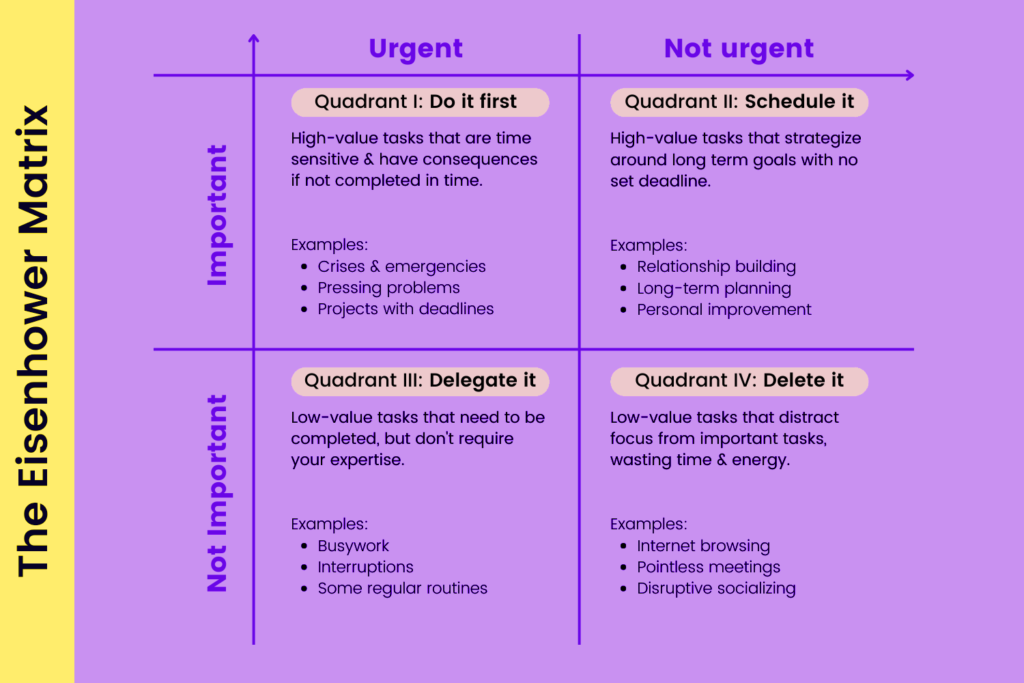Mastering Productivity: How to Prioritize Effectively with the Eisenhower Matrix
Learn how to prioritize tasks, reduce stress, and achieve optimal productivity. Explore real-life examples and personalized strategies for mastering this powerful tool
The secrets of effective time management with the Eisenhower Matrix. Learn how to prioritize tasks, reduce stress, and achieve optimal productivity. Explore real-life examples and personalized strategies for mastering this powerful tool.
Introduction
In the hustle and bustle of daily life, managing time efficiently poses a significant challenge. The Eisenhower Matrix emerges as a beacon of order amid this chaos. This strategic tool not only categorizes tasks but also transforms how we approach productivity. In this comprehensive guide, we will unravel the mysteries of the Eisenhower Matrix, navigating through its origins and intricacies. Prepare to embark on a journey that promises to revolutionize your time management skills, helping you conquer tasks with precision and purpose. It’s time to delve into the world of prioritization and discover the transformative potential of this remarkable matrix.

Understanding the Eisenhower Matrix
The Eisenhower Matrix, named after President Dwight D. Eisenhower, is a powerful time management tool designed to enhance productivity by categorizing tasks based on their urgency and importance.
Basic Concept: At its core, the matrix classifies tasks into four quadrants:
- Urgent and Important:
- Tasks in this quadrant demand immediate attention and are crucial to your goals.
- Examples include pressing deadlines, emergencies, and essential work responsibilities.
- Important but Not Urgent:
- This quadrant encompasses tasks that contribute to your long-term goals but lack immediate urgency.
- Examples include strategic planning, skill development, and relationship-building.
- Urgent but Not Important:
- Tasks here are time-sensitive but don’t significantly contribute to your overarching objectives.
- Examples include some meetings, interruptions, and certain phone calls.
- Not Urgent and Not Important:
- Tasks in this quadrant are neither time-sensitive nor crucial for your goals.
- Examples include excessive social media browsing, trivial activities, and unnecessary distractions.

Understanding and strategically placing tasks within these quadrants provides a framework for prioritization, allowing individuals to focus on what truly matters and allocate their time and energy effectively. The Eisenhower Matrix serves as a visual guide, aiding in the decision-making process and fostering a more organized and productive approach to tasks.
Benefits of Using the Eisenhower Matrix
Embracing the Eisenhower Matrix brings forth a multitude of benefits, transforming the way individuals approach time management and decision-making.
1. Clear Prioritization:
- The matrix provides a crystal-clear framework for categorizing tasks, ensuring that priorities are distinctly identified.
- Users gain a comprehensive view of what needs immediate attention versus what can be scheduled for the future.
2. Enhanced Decision Making:
- By categorizing tasks into urgency and importance, the matrix simplifies decision-making processes.
- Users can make informed choices on where to direct their time and effort, leading to more effective and purposeful actions.
3. Reduced Procrastination:
- The matrix prompts individuals to confront tasks rather than procrastinate.
- Tasks that fall into the “Important but Not Urgent” quadrant are often neglected, and the matrix helps address them in a timely manner.
4. Stress Reduction:
- Clarity in prioritization minimizes the stress associated with overwhelming workloads.
- The matrix allows users to focus on tasks that align with their goals, reducing the anxiety that comes from feeling constantly rushed or disorganized.
5. Goal Alignment:
- The Eisenhower Matrix aligns tasks with overarching goals, fostering a sense of purpose and direction.
- It ensures that valuable time is dedicated to activities that contribute to long-term success.
6. Efficient Time Allocation:
- Users can allocate their time and resources more efficiently by concentrating on tasks that truly matter.
- It aids in avoiding the trap of spending disproportionate time on activities that yield minimal impact.
In summary, the Eisenhower Matrix is a transformative tool that empowers individuals to optimize their time, make informed decisions, and alleviate the stress associated with managing competing priorities.
Eisenhower’s Time Management Philosophy
Delving into the historical roots of the Eisenhower Matrix unveils the profound time management philosophy of Dwight D. Eisenhower, the 34th President of the United States and a five-star general.
Context and Origin: In the 1950s, Eisenhower faced the daunting challenge of navigating complex military and political decisions during his presidency. Confronted by a constant stream of urgent matters, he needed a systematic approach to manage his time effectively. This necessity gave birth to the Eisenhower Matrix.
Philosophy of Urgency and Importance: Eisenhower’s philosophy was grounded in the distinction between urgency and importance. He believed that tasks could be categorized based on these two factors, leading to a more strategic approach to decision-making and time allocation.
Military Precision in Time Management: As a former military leader, Eisenhower applied principles of military strategy to time management. He understood the significance of aligning tasks with overarching objectives, much like coordinating troops to achieve a specific mission.
Legacy of Prioritization: Eisenhower’s time management philosophy left an enduring legacy. The matrix not only served as a personal tool for the President but became a widely adopted method for individuals and professionals seeking to enhance productivity.
Balance in Decision-Making: Eisenhower emphasized finding a balance between handling urgent matters and focusing on tasks with long-term significance. This approach aimed to prevent the constant firefighting mode and promote a strategic, goal-oriented mindset.
In adopting the Eisenhower Matrix, individuals inherit not just a time management tool but a philosophy rooted in military precision, strategic thinking, and a commitment to balancing urgency and importance in the pursuit of effective decision-making and productivity.
Implementing the Eisenhower Matrix Effectively
Step-by-Step Guide: Implementing the Eisenhower Matrix is a straightforward yet powerful process to enhance decision-making and time management. Follow these steps:
- List Your Tasks: Begin by listing all the tasks you need to accomplish.
- Assess Urgency and Importance: Evaluate each task based on its urgency and importance. Urgency pertains to time sensitivity, while importance relates to the task’s impact on long-term goals.
- Quadrant Placement: Place each task in one of the four quadrants:
- Urgent and Important: Tasks that need immediate attention.
- Important but Not Urgent: Tasks with a significant impact but no immediate deadline.
- Urgent but Not Important: Tasks that demand attention but contribute less to long-term goals.
- Not Urgent and Not Important: Low-priority tasks that can be deferred or delegated.
- Prioritize Actions: Begin with tasks in the Urgent and Important quadrant, followed by Important but Not Urgent. Delegate or reconsider tasks in the Urgent but Not Important quadrant, and minimize or eliminate tasks in the Not Urgent and Not Important quadrant.
Decision-Making Process:
- Quadrant I (Urgent and Important): Immediate action is crucial. Focus on resolving these tasks promptly to prevent escalation.
- Quadrant II (Important but Not Urgent): Invest time in strategic planning and goal-setting. These tasks contribute to long-term success.
- Quadrant III (Urgent but Not Important): Assess whether these tasks can be delegated or streamlined to minimize time investment.
- Quadrant IV (Not Urgent and Not Important): Evaluate the necessity of these tasks. Eliminate or delegate to free up valuable time.
By systematically categorizing tasks, the Eisenhower Matrix becomes a practical tool for making informed decisions and optimizing time for tasks that align with your overarching goals.
Tips for Successful Implementation
Mastering the Eisenhower Matrix requires finesse and consistency. Here are some tips to ensure successful implementation:
- Regular Updates: Keep your matrix dynamic by regularly updating it. As priorities shift, tasks may move between quadrants.
- Be Realistic: Accurately assess the urgency and importance of each task. Avoid the temptation to label everything as urgent or important.
- Set Time Limits: Allocate specific time blocks for each quadrant. This prevents spending excessive time on less critical tasks.
- Delegate Wisely: Embrace delegation for tasks in the Urgent but Not Important quadrant. This empowers others and allows you to focus on high-priority matters.
- Flexibility is Key: Understand that priorities may change. Be flexible in adapting to new information or unforeseen circumstances.
- Batch Similar Tasks: Group similar tasks within a quadrant to streamline your workflow. This minimizes mental transitions between different types of activities.
- Review and Reflect: Regularly review completed tasks and assess their impact. Reflect on what worked well and where adjustments can be made.
Quick Decision-Making Strategies:
- Use Intuition: Trust your instincts when deciding task placement. Initial judgments often align with your subconscious understanding of priorities.
- Time Constraint Rule: If you’re unsure about a task’s urgency or importance, set a brief time limit for decision-making. This prevents overthinking.
- Consider Impact: Evaluate tasks based on their potential impact. Tasks with significant long-term consequences should be prioritized.
By incorporating these tips, you’ll maximize the effectiveness of the Eisenhower Matrix, making it a seamless part of your daily decision-making and time management routine.
Common Mistakes to Avoid
Navigating the Eisenhower Matrix can be tricky, and pitfalls are not uncommon. Here’s a guide on common mistakes to steer clear of:
- Procrastination on Important Tasks: Avoid delaying tasks in the Important but Not Urgent quadrant. While they may not demand immediate attention, neglecting them can lead to future urgency.
- Overlooking the ‘Not Urgent, Not Important’ Quadrant: Some tasks fall into this category, and they might be better off eliminated or delegated. Ignoring this quadrant can result in time wasted on non-essential activities.
- Misjudging Urgency: Failing to accurately assess the urgency of a task can lead to misplaced priorities. Take a moment to evaluate whether a task genuinely requires immediate attention.
- Inflexibility: The matrix is a tool, not a rigid rule. Some tasks may defy categorization or require adjustment. Be flexible and willing to adapt.
- Ignoring Changes in Priority: As circumstances change, so do priorities. Regularly reassess and update your matrix to align with shifting demands.
- Incomplete Information: Making decisions without adequate information can lead to misclassification. Ensure you have a clear understanding of a task before placing it in a quadrant.
- Failure to Delegate: If you attempt to tackle everything yourself, burnout is inevitable. Delegate tasks appropriately, especially in the Urgent but Not Important quadrant.
By sidestepping these common missteps, you’ll optimize your use of the Eisenhower Matrix, turning it into a reliable ally for effective time management and decision-making.
Case Studies: Real-Life Applications
The Eisenhower Matrix has proven its versatility through numerous real-life success stories. Here are compelling case studies illustrating its impactful applications:
- Entrepreneurial Triumph with Jane’s Startup: Jane, a startup founder, utilized the matrix to navigate the challenges of launching her business. Prioritizing tasks helped her balance immediate needs with long-term goals. This approach played a pivotal role in the steady growth of her venture.
- Educational Excellence in Mr. Johnson’s Classroom: High school teacher Mr. Johnson employed the matrix to manage lesson planning effectively. By categorizing tasks by urgency and importance, he tailored his teaching approach, ensuring students’ immediate needs and long-term educational goals were addressed with precision.
- Personal Productivity Journey of Sarah: Sarah, a busy professional juggling work and personal commitments, applied the matrix to her daily life. This empowered her to allocate time wisely, leading to reduced stress and improved work-life balance.
These case studies demonstrate the universal applicability of the Eisenhower Matrix, showcasing its transformative effects in various settings. By learning from these examples, individuals and organizations can harness the matrix for tailored and successful time management strategies.
Adapting the Matrix to Personal Needs
The beauty of the Eisenhower Matrix lies in its adaptability to diverse needs and preferences. Here’s how you can tailor this powerful tool to suit your individual goals:
The matrix, originally designed for strategic decision-making, seamlessly integrates into various aspects of personal and professional life. Its flexibility allows users to customize the criteria for urgency and importance based on their unique circumstances.
1. Tailoring Urgency and Importance Definitions: Embrace the flexibility of the matrix by adjusting your definitions of urgency and importance. What might be urgent for one person may not hold the same urgency for another. Likewise, your definition of importance could be influenced by your personal or professional objectives.
2. Customizing Quadrant Criteria: Feel free to redefine the criteria for each quadrant. Your ‘Urgent and Important’ quadrant might include tasks that align with your immediate personal goals, while ‘Not Urgent and Not Important’ could cover activities that contribute to your long-term well-being.
3. Aligning with Personal Goals: Adapt the matrix to resonate with your personal goals and values. Consider integrating your life vision into the decision-making process, ensuring that tasks align not only with professional obligations but also with your broader life aspirations.
4. Experimenting for Optimal Results: Treat the matrix as a dynamic tool. Experiment with different approaches until you find a customized version that aligns seamlessly with your workflow and personal aspirations.
By recognizing and embracing the adaptability of the Eisenhower Matrix, individuals can craft a personalized approach to time management that complements their unique lifestyles and ambitions.
FAQs Section
1. What is the Eisenhower Matrix? The Eisenhower Matrix is a time management tool that categorizes tasks into four quadrants based on urgency and importance. It provides a visual framework to prioritize activities effectively.
2. How do I prioritize tasks using the matrix? Prioritization involves placing tasks into quadrants based on their urgency and importance. Focus on tasks in the “Urgent and Important” quadrant first, then proceed to others as needed.
3. Can the matrix be applied in personal life? Absolutely. The matrix extends beyond professional settings, helping individuals organize personal tasks, manage goals, and strike a balance between responsibilities and personal pursuits.
4. Is the Urgent-Important principle universally applicable? While universally effective, the interpretation of urgency and importance may vary. Users should customize definitions based on their unique circumstances and goals.
5. What tools can help implement the Eisenhower Matrix digitally? Several digital tools, including productivity apps and project management software, offer built-in Eisenhower Matrix features. Trello, Todoist, and Microsoft Excel are popular choices.
6. How often should I reassess my priorities with the matrix? Regular reassessment is vital. Set aside time weekly or monthly to review and adjust priorities as circumstances change or new tasks emerge.
7. Are there any alternatives to the Eisenhower Matrix? Yes, alternatives like the Covey Time Management Matrix or the ABCD method exist. However, the Eisenhower Matrix remains widely recognized for its simplicity and effectiveness.
8. Can the matrix be used in a team or professional setting? Absolutely. The matrix is versatile and can be applied collaboratively. In a professional setting, teams can collectively prioritize tasks and align goals using the matrix.
As with any tool, understanding its nuances enhances effectiveness. These FAQs provide insights into the Eisenhower Matrix’s application, ensuring users can maximize its benefits across various contexts.






